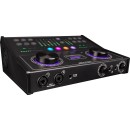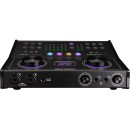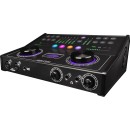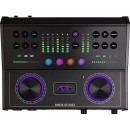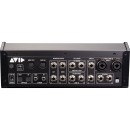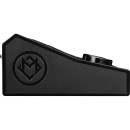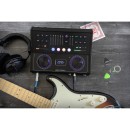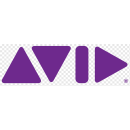Avid MBOX Studio Audio Interface with Pro Tools Software: Complete Review
- High-quality audio interface with 24-bit/192kHz resolution for professional-grade sound.
- Includes Pro Tools software for comprehensive music production and editing.
- Eight analog inputs including four mic/line combo inputs with high-quality preamps.
- Four analog outputs plus stereo headphone outputs for flexible monitoring.
- MIDI I/O for connecting keyboards, controllers, and other MIDI devices.
- Low-latency monitoring with built-in DSP for reverb and delay effects.
- Comprehensive I/O options including ADAT, S/PDIF, and Bluetooth connectivity.
- User-friendly interface with dedicated controls for key functions.
- Compact and rugged design suitable for studio or mobile use.
- Compatible with Mac and Windows operating systems.
Detailed Specifications, Advantages, and Disadvantages
The Avid MBOX Studio Audio Interface with Pro Tools Software is a professional-grade audio interface designed for musicians, producers, and sound engineers looking for superior sound quality and versatility. With its high-resolution 24-bit/192kHz converters and ultra-low latency monitoring, it ensures that your recordings are crystal clear and true to the original source.
Featuring a range of inputs and outputs, the MBOX Studio includes four XLR/TRS combo inputs, ADAT I/O, and SPDIF I/O, making it adaptable for various recording setups. The interface is equipped with MIDI I/O for integrating external hardware, and it supports up to eight simultaneous inputs. Its rugged build and desktop-friendly design make it a reliable addition to any professional or home studio.
Bundled with the industry-standard Pro Tools Software, this audio interface provides users with powerful tools for recording, mixing, and editing audio. Pro Tools offers an intuitive interface and a vast array of virtual instruments, effects, and plugins, empowering creators to bring their musical visions to life. Combined, the Avid MBOX Studio Audio Interface with Pro Tools Software delivers a comprehensive solution for all your audio production needs.
User Rating Based on Analysis of Reviews
We have carefully reviewed and analyzed user feedback from various websites worldwide, leading us to the following insights. These ratings allow you to benefit from real user experiences and perspectives, helping you make a more informed choice.
Purchase Value
85% of users were satisfied with the purchase value of the Avid MBOX Studio, citing its comprehensive features and the inclusion of Pro Tools software as excellent value for money. Many highlighted the competitive pricing compared to other interfaces with similar capabilities, making it a worthy investment for both beginners and seasoned audio professionals.
15% of users expressed dissatisfaction, primarily due to the initial cost being higher than some entry-level competitors. A few users felt that the bundled software did not add enough value to justify the price difference, especially if they already owned similar software.
Quality of Materials
90% of users praised the quality of materials used in the Avid MBOX Studio, noting its robust build and premium feel. Many commented on its durability and the high-quality finish, which gives it a professional look and feel, ensuring longevity and reliability in various environments.
10% of users were less impressed, with some reporting issues with the durability of specific components, such as knobs or buttons. A few mentioned that while the main body was sturdy, certain parts felt less reliable over time.
Ease of Use
75% of users found the Avid MBOX Studio easy to use, appreciating the intuitive interface and seamless integration with the Pro Tools software. Many noted that the setup process was straightforward, allowing them to focus on their creative projects without technical hurdles.
25% of users experienced challenges, particularly newcomers to audio interfaces. Some found the initial setup complicated, requiring additional research or support, and a few mentioned that navigating the software could be daunting without prior experience.
Sound Quality
95% of users were highly satisfied with the sound quality provided by the Avid MBOX Studio, praising its clear and accurate audio reproduction. The preamps and converters were frequently highlighted as exceptional, making it a preferred choice for professional-grade recordings.
5% of users were less impressed, with some suggesting that while the sound quality was generally good, it did not significantly outperform other high-end alternatives. A small number of users encountered minor issues with noise or interference in specific setups.
Software Integration
80% of users appreciated the seamless integration of the MBOX Studio with Pro Tools software, noting that it enhanced their workflow and provided a cohesive user experience. Many users found the software bundle a valuable addition that complemented the hardware's capabilities.
20% of users faced integration issues, with some reporting difficulties with compatibility or software updates. A few users felt constrained by the software's learning curve, particularly if they were accustomed to different audio editing programs.
Customer Support
70% of users were satisfied with the customer support provided by Avid, finding the team responsive and helpful in resolving issues. Many appreciated the availability of online resources and forums that supplemented direct support.
30% of users were dissatisfied with customer support, citing long response times and unhelpful interactions. Some users felt that their issues remained unresolved or were inadequately addressed, leading to frustration.
Portability
65% of users found the Avid MBOX Studio reasonably portable, appreciating its compact design that facilitated easy transportation for mobile recording sessions or live performances.
35% of users felt that the device was somewhat bulky compared to other portable interfaces, making it less convenient for frequent travel. Some users desired a more lightweight option for their on-the-go needs.
Durability
85% of users commended the durability of the Avid MBOX Studio, citing its solid construction and ability to withstand regular use without significant wear and tear. Many users felt confident in its performance over time, even in demanding environments.
15% of users reported concerns about the long-term durability of certain components, such as surface wear or potential hardware failures. A few experienced issues after extended use, questioning the overall longevity.
Connectivity Options
90% of users were pleased with the wide range of connectivity options available, including multiple inputs and outputs that allowed for versatile setups. The ability to connect a variety of devices and instruments was particularly valued by users with complex audio configurations.
10% of users found the connectivity options lacking, particularly those who required specific ports that were not included. Some users mentioned the need for additional adapters or equipment to meet their specific connectivity needs.
Latency Performance
85% of users were satisfied with the low-latency performance of the Avid MBOX Studio, noting minimal delay during recording and playback. This was seen as a crucial advantage for real-time monitoring and precise editing.
15% of users experienced latency issues, particularly in complex sessions or when using multiple plug-ins. A few users found the latency problematic, impacting their ability to work efficiently in certain scenarios.
Aesthetics
80% of users appreciated the aesthetic design of the Avid MBOX Studio, highlighting its sleek and modern appearance that complemented their studio setups. The visual appeal was an added bonus for users who valued both function and form.
20% of users were less impressed with the design, feeling that it lacked distinctiveness or failed to match the aesthetics of their existing equipment. Some users desired more customizable options to better fit their personal style.
User Interface
75% of users found the user interface intuitive and straightforward, allowing them to navigate features and settings with ease. This was particularly beneficial for users familiar with Avid's ecosystem.
25% of users struggled with the user interface, particularly those new to audio interfaces or Pro Tools. Some found it unintuitive or cluttered, requiring additional time to learn and adapt.
Software Updates
65% of users appreciated the regular software updates provided by Avid, which often included improvements and new features that enhanced the overall user experience.
35% of users were dissatisfied with the frequency or impact of software updates, citing occasional bugs or compatibility issues that disrupted their workflow. Some users found the updates intrusive or unnecessary.
Headphone Amplifier Quality
85% of users were impressed with the headphone amplifier quality, noting clear and powerful sound that allowed for detailed monitoring. This was a significant advantage for users who relied heavily on headphones for mixing and editing.
15% of users found the headphone amplifier quality lacking, particularly at higher volumes where distortion was occasionally noted. Some users desired a more robust output for professional-grade headphones.
Compatibility with Other DAWs
70% of users found the MBOX Studio compatible with other DAWs, appreciating the flexibility to switch between different software environments without major issues.
30% of users faced compatibility challenges, especially when integrating with DAWs other than Pro Tools. Some users encountered technical difficulties or required additional setup steps to achieve seamless operation.
Expandability
75% of users valued the expandability options available with the Avid MBOX Studio, allowing them to add additional components or upgrade their setup as needed. This was especially beneficial for users with growing audio production needs.
25% of users felt limited by the expandability options, noting restrictions in adding certain types of equipment or configurations. Some users desired more straightforward or cost-effective expansion paths.
Power Supply Options
80% of users were content with the power supply options, finding them adequate for both studio and mobile use. The flexibility to power the device in various settings was a notable benefit.
20% of users expressed dissatisfaction with the power supply options, particularly those needing battery-operated solutions for remote recording. Some users found the existing options limiting for certain use cases.
Driver Stability
85% of users experienced stable driver performance, noting that the MBOX Studio operated reliably across different systems and setups. This stability was crucial for uninterrupted audio production.
15% of users encountered driver issues, with some reporting crashes or instability during critical sessions. A few users found the driver installation process cumbersome or prone to errors.
Microphone Preamps
90% of users praised the microphone preamps, noting their high-quality sound reproduction and low noise levels. This was particularly appreciated by users recording vocals or acoustic instruments.
10% of users were less impressed, with some suggesting that the preamps did not significantly outperform other high-end interfaces. A few users desired even lower noise floors or additional features.
Bundled Software Value
85% of users felt that the bundled Pro Tools software added significant value, offering a comprehensive suite of tools that complemented the hardware capabilities of the MBOX Studio.
15% of users found the bundled software less valuable, particularly if they were already users of other DAWs or if they did not require the full feature set offered by Pro Tools. Some users preferred a more customizable software bundle.
In the following sections, we will delve into a detailed review of the Avid MBOX Studio Audio Interface with Pro Tools Software. This comprehensive analysis will cover all the specifications, highlight the advantages, and discuss the disadvantages of this product, helping you make an informed decision.
Pros:
- High-quality audio conversion and preamps ensure professional-grade sound.
- Seamless integration with Pro Tools software for a streamlined workflow.
- Multiple input and output options provide flexibility for various recording needs.
- Robust build quality ensures durability and longevity.
- Comes with a comprehensive software bundle, including Pro Tools and other useful plugins.
Cons:
- Higher price point compared to other audio interfaces in the market.
- May have a steep learning curve for beginners unfamiliar with Pro Tools.
- Limited compatibility with non-Avid software might restrict some users.
- Not as portable as smaller, more compact audio interfaces.
General
| Channels of I/O | Analog: 9 Inputs / 10 Outputs Digital: 12 Inputs / 12 Outputs |
|---|---|
| Built-In DSP | Yes |
| Maximum Sampling Rate | 192 kHz / 24-Bit |
| Number of Microphone Inputs | 4 Preamps |
| Built-In Microphone | (Talkback) |
| Input Level Adjustment | 1x Knob |
| Expansion Slots |
Channels of I/O: The MBOX Studio provides a versatile audio interface with both analog and digital connectivity options. With 9 analog inputs and 10 outputs, as well as 12 digital inputs and outputs, this setup allows for extensive routing capabilities. This means users can easily connect multiple instruments, microphones, and other audio sources simultaneously, facilitating complex recording sessions and live performances.Show More
Built-In DSP: The inclusion of built-in Digital Signal Processing (DSP) allows for real-time audio effects and processing without the need for excessive CPU resources on your computer. This feature is particularly beneficial in a studio environment, as it enables users to apply effects while recording or mixing, leading to a more efficient workflow and improved audio quality.
Maximum Sampling Rate: The MBOX Studio supports a maximum sampling rate of 192 kHz and 24-bit depth. This high-quality specification ensures that audio recordings capture a wide frequency range and dynamic range, resulting in clear and detailed sound. Higher sampling rates are especially important for professional audio work, where fidelity is paramount.
Number of Microphone Inputs: Equipped with four preamps, the MBOX Studio allows users to connect multiple microphones for recording. This is ideal for situations such as band recordings, podcasts, or voice-over work where multiple audio sources need to be captured simultaneously, providing flexibility in audio production.
Built-In Microphone: The inclusion of a talkback microphone enhances communication within the studio, allowing users to easily communicate with performers or other engineers without needing additional equipment. This feature streamlines the workflow during recording sessions, making it easier to coordinate efforts and provide directions.
Input Level Adjustment: With a single knob for input level adjustment, users can quickly and easily set the gain for their audio sources. This intuitive control allows for precise level management, ensuring that recordings maintain optimal signal levels without distortion or clipping, which is crucial for achieving high-quality audio.
Expansion Slots: The MBOX Studio does not feature expansion slots, meaning that its capabilities are fixed and not upgradable. While this may limit future enhancements, the built-in features are designed to meet the needs of most users, making it a reliable choice for various audio production tasks without the complexity of additional hardware.
Signal Processing
| Pad | -10 dB (Switchable per Channel) |
|---|---|
| Gain/Trim Range | Mic/Line/Hi-Z Inputs: 60 dB |
| High-Pass Filter | 100 Hz (via Software) |
| Solo/Mute | Mute per Master |
Pad: The pad feature allows for a reduction in the input level by a specified amount, in this case, -10 dB. This is particularly useful when dealing with loud sound sources that could potentially overload the input, such as drums or amplified instruments. The switchable aspect per channel gives users the flexibility to tailor the input settings for different sources, ensuring optimal recording levels without distortion.Show More
Gain/Trim Range: The gain or trim range of 60 dB for Mic/Line/Hi-Z inputs indicates the amount of amplification that can be applied to the incoming signal. A wider range allows for better control over the input level, accommodating various audio sources from soft vocals to loud instruments. This feature ensures that users can achieve a balanced mix and maintain audio fidelity regardless of the source's output level.
High-Pass Filter: The high-pass filter set at 100 Hz is a useful tool for eliminating low-frequency noise that can muddy recordings, such as handling noise or low-end rumble from microphones. By utilizing this filter via software, users can enhance clarity in their recordings, focusing on the desired frequency range without unwanted low-end interference.
Solo/Mute: The solo/mute feature allows for the management of audio channels during mixing. The capability to mute per master provides a streamlined approach to controlling what is heard in the mix, enabling users to isolate specific tracks or silence others as needed. This flexibility is essential for achieving a polished final product by ensuring that each element can be assessed and adjusted independently.
Connectivity
| Analog Audio I/O | 2x Combo XLR-1/4" TRS Balanced/Unbalanced Mic/Line/Hi-Z Input (Front Panel) 2x Combo XLR-1/4" TRS Balanced/Unbalanced Mic/Line Input 2x 1/4" TRS Balanced Line Input 2x 1/4" TRS Balanced Line/FX Return 2x 1/4" TRS Balanced/Unbalanced Line/Hi-Z/FX Send 2x 1/4" TRS Unbalanced Headphone Output 4x 1/4" TRS Balanced Monitor Output 1x 1/4" TS Unbalanced Re-Amp Output |
|---|---|
| Phantom Power | 48 V, Selectable On/Off (Selectable on Individual Inputs) |
| Digital Audio I/O | 1x TOSLINK Optical ADAT Input 1x TOSLINK Optical ADAT Output 1x RCA Coaxial S/PDIF Input 1x RCA Coaxial S/PDIF Output |
| Host Connection | 1x USB-C (Class-Compliant, on Interface) |
| Host Connection Protocol | USB 2.0 |
| USB (Non-Host) | |
| Sync I/O | |
| Network I/O | |
| MIDI I/O | 1x DIN 5-Pin Input 1x DIN 5-Pin Output |
| Other I/O | 2x 1/4" Footswitch/Control Input |
| Wireless | Bluetooth |
| Wireless Connectivity | Bluetooth (Audio Streaming) |
Analog Audio I/O: This section details the various analog input and output connections available on the Avid MBOX Studio. With multiple combo XLR-1/4" TRS inputs, users can connect a range of microphones, instruments, and line-level devices. The presence of Hi-Z inputs also allows for direct connection of high-impedance instruments like electric guitars. The array of outputs, including balanced monitor outputs and headphone outputs, ensures flexibility in routing audio for monitoring and performance.Show More
Phantom Power: The interface provides selectable 48V phantom power, which is crucial for powering condenser microphones. This feature can be toggled on or off for individual inputs, allowing users to customize their setup based on the type of microphones or instruments they are using. Having this option enhances versatility, especially in diverse recording situations.
Digital Audio I/O: This feature includes optical ADAT and coaxial S/PDIF connections for digital audio input and output. These digital connections enable high-quality audio transfer between devices, eliminating potential noise issues associated with analog connections. The inclusion of both ADAT and S/PDIF makes it easier to expand audio setups and integrate with other digital equipment.
Host Connection: The Avid MBOX Studio connects to a computer via a USB-C connection, which supports USB 2.0 protocols. This ensures compatibility with a wide range of devices and provides a reliable data transfer pathway for high-quality audio streaming. The non-host USB capability indicates that the device does not support hosting other USB devices, which is typical for audio interfaces focused on recording and playback.
MIDI I/O: The presence of a DIN 5-pin MIDI input and output allows for integration with MIDI devices, such as keyboards and controllers. This feature is essential for users who wish to incorporate MIDI data into their recordings, enabling greater creative possibilities in music production.
Wireless Connectivity: The Avid MBOX Studio includes Bluetooth functionality for audio streaming. This allows users to connect wirelessly to compatible devices, enhancing convenience and flexibility in setups where wired connections may be impractical. This feature is particularly beneficial for mobile recording applications and casual listening scenarios.
Performance
| Frequency Response | Mic, Line, Hi-Z Inputs: 20 Hz to 20 kHz ±0.125 dB Line, Monitor Outputs: 20 Hz to 20 kHz ±0.125 dB Headphone Outputs: 20 Hz to 20 kHz ±0.2 dB Hi-Z Outputs: 20 Hz to 20 kHz ±0.3 dB |
|---|---|
| Maximum Input Level | Mic/Line/Hi-Z Inputs: +14 dBu |
| Maximum Output Level | Line/Main Outputs: +19 dBu |
| Headphone Output Power | 120 mW into 32 Ohms |
| Dynamic Range | Mic/Line Inputs: 112 dB Hi-Z Inputs: 108 dB Line/Monitor Outputs: 110 dB Headphone Outputs: 102 dB Hi-Z Outputs: 103 dB |
| THD+N | Mic/Line Inputs: 0.001% Hi-Z Inputs: 0.004% Monitor Outputs: 0.0012% Line/Hi-Z Outputs: 0.002% |
| EIN | Mic Inputs: -129 dBu A-Weighted |
The Frequency Response specification indicates the range of frequencies that the MBOX Studio can effectively process and reproduce. For the Mic, Line, and Hi-Z inputs, a frequency range of 20 Hz to 20 kHz ±0.125 dB ensures that the audio captured retains its natural tone and clarity across the audible spectrum. Similarly, the Line and Monitor outputs maintain this range, essential for accurate playback. The slight variations in headphone and Hi-Z outputs still fall within this range, indicating a consistent performance across all output types.Show More
Maximum Input Level refers to the highest signal level that the device can handle without distortion or clipping. With a maximum input level of +14 dBu for Mic, Line, and Hi-Z inputs, users can record strong audio signals without fear of overloading the system. This feature is crucial for professional audio applications where dynamic range can be significant.
The Maximum Output Level specifies the highest level of audio that can be outputted from the device, with the Line/Main outputs reaching +19 dBu. This is particularly important for ensuring that the audio signal is strong enough for various playback systems or for further processing without degradation in quality.
Headphone Output Power measures the power delivered to headphones, rated at 120 mW into 32 Ohms. This level of power allows for clear sound reproduction even at higher volumes, making it ideal for monitoring audio during recording sessions.
Dynamic Range quantifies the difference between the smallest and largest signals the device can process, expressed in dB. The MBOX Studio boasts a dynamic range of 112 dB for Mic/Line inputs and 110 dB for Line/Monitor outputs, indicating excellent capability in capturing both quiet and loud sounds without distortion.
THD+N, or Total Harmonic Distortion plus Noise, represents the amount of distortion and noise in the audio signal. The MBOX Studio maintains a low THD+N across all inputs and outputs, with values as low as 0.001% for Mic/Line inputs. This low percentage ensures that the audio remains clean and true to the original source.
Finally, EIN, or Equivalent Input Noise, measures the inherent noise of the device's Mic inputs, rated at -129 dBu A-Weighted. A lower EIN indicates a quieter operation, allowing for clearer recordings, especially in sensitive audio applications where background noise can be a concern.
Digital Audio
| Sample Rates | Up to 192 kHz |
|---|---|
| Sample Rate Conversion | |
| Bit Depths | 24-Bit |
| Sync Sources | ADAT, Internal, S/PDIF |
Sample Rates indicate the frequency at which audio is recorded and played back. The Avid MBOX Studio supports sample rates of up to 192 kHz, which allows for high-resolution audio capture and playback. This high sample rate is beneficial for professional audio production, as it provides greater detail and clarity in sound, making it ideal for music recording, mixing, and mastering.Show More
Sample Rate Conversion refers to the ability of the device to change the sample rate of audio signals. In this case, the Avid MBOX Studio does not support sample rate conversion. This means that users must ensure their audio sources are set to the correct sample rate before recording or playback, as mismatched rates can lead to audio quality issues or playback errors.
Bit Depths determine the dynamic range of the audio signal. The Avid MBOX Studio operates at a 24-Bit depth, which allows for a much wider dynamic range than standard 16-Bit audio. This increased bit depth results in more detailed sound and less noticeable noise, making it particularly advantageous for capturing intricate audio performances and nuances in music.
Sync Sources refer to the different methods by which the device can synchronize its clock with other audio devices. The Avid MBOX Studio supports various sync sources, including ADAT, Internal, and S/PDIF. This versatility enables users to integrate the interface seamlessly into different studio setups, ensuring accurate timing and alignment of audio tracks when working with multiple devices.
Audio Storage & Playback
| Memory Card Slot |
|---|
The Memory Card Slot feature indicates whether the Avid MBOX Studio Audio Interface includes a slot for external memory cards. In this case, the absence of a memory card slot means users cannot expand storage options through external media. This can impact how users manage their audio files, as they will need to rely on internal storage or connected devices for file management and recording sessions.Show More
Having a memory card slot can be beneficial for professionals who require additional storage for large projects or want to easily transfer files between devices. Without this feature, users may need to employ alternative methods such as external hard drives or cloud storage solutions to accommodate their storage needs, which could potentially affect workflow efficiency during recording and production processes.
Compatibility
| OS Compatibility | macOS Windows |
|---|---|
| Mobile Device Compatibility | |
| Required Hardware | USB Cable (Included) Available USB-A Port or USB-C Port |
| Internet Connection | Required for Registration, Software/Driver Download |
OS Compatibility refers to the operating systems that the Avid MBOX Studio Audio Interface is designed to work with. In this case, it is compatible with both macOS and Windows. This means that users on either of these platforms can seamlessly integrate the audio interface into their music production setup, allowing them to utilize its features without compatibility issues. The support for these major operating systems ensures that a wide range of users can take advantage of the MBOX Studio's capabilities.Show More
Mobile Device Compatibility indicates whether the audio interface can be used with mobile devices. In this case, the Avid MBOX Studio does not support mobile devices, which may limit its use for users who prefer to work on tablets or smartphones. This feature is important for those who are looking for a portable solution for recording and producing audio on-the-go, as they would need to consider other options if mobile compatibility is a priority.
Required Hardware outlines the hardware components needed to use the MBOX Studio. It specifies that a USB cable is included and that users must have either a USB-A or USB-C port available on their device. This information is crucial, as it informs potential buyers about the necessary connections and ensures they have the right setup to fully utilize the audio interface. The presence of both USB-A and USB-C compatibility enhances flexibility for various users.
Internet Connection is required for the registration process and for downloading software or drivers necessary for the MBOX Studio to function optimally. This requirement is relevant for users who may be using the device for the first time or require updates to the software. An internet connection ensures that users can access the latest features and improvements, which can enhance their overall experience with the audio interface.
Power
| Power Requirements | AC/DC Power Adapter (Included) |
|---|---|
| AC/DC Power Adapter | 12 VDC, Center-Positive (Included) |
The Power Requirements feature of the Avid MBOX Studio Audio Interface indicates the type of power supply needed for the device to function properly. In this case, the interface operates using an AC/DC power adapter, which is included with the purchase. This means users do not need to buy a separate power supply, making setup more convenient and straightforward.Show More
The specification further details that the power adapter provides 12 VDC (volts direct current) and is center-positive. This is important for ensuring that the device receives the correct voltage and polarity, which is crucial for its operation. Using the correct power specifications helps prevent damage to the audio interface and ensures optimal performance while recording and producing audio.
Physical
| Anti-Theft Features | Kensington Security Slot |
|---|---|
| Dimensions | 11.3 x 8.9 x 4.1" / 28.7 x 22.6 x 10.4 cm |
| Weight | 6.1 lb / 2.8 kg |
Anti-Theft Features: The inclusion of a Kensington Security Slot provides users with an added layer of security for the Avid MBOX Studio Audio Interface. This feature allows users to attach a compatible security lock, which helps to deter theft, especially in shared or public environments like studios or educational facilities. The presence of such a feature is essential for professionals who want to ensure the safety of their equipment during sessions or when traveling.Show More
Dimensions: The dimensions of the Avid MBOX Studio Audio Interface, measuring 11.3 x 8.9 x 4.1 inches (or 28.7 x 22.6 x 10.4 cm), indicate a compact design that is suitable for both studio settings and mobile recording. A smaller footprint makes it more manageable and easier to fit into various setups, whether on a desktop or in a mobile rig, ensuring that it can be used effectively in diverse environments without taking up excessive space.
Weight: Weighing in at 6.1 pounds (2.8 kg), the MBOX Studio is relatively lightweight for an audio interface with robust features. This weight is ideal for musicians and audio professionals who need to transport their equipment frequently. A lighter device allows for ease of handling and portability, making it convenient for on-the-go recording or live performances without sacrificing functionality.
Packaging Info
| Package Weight | 10.85 lb |
|---|---|
| Box Dimensions (LxWxH) | 17.8 x 14.3 x 9.8" |
The Package Weight of 10.85 lb indicates the total weight of the Avid MBOX Studio Audio Interface when packaged. This weight is significant for shipping and handling considerations, as it affects transportation costs and the ease of portability for users. A heavier package may suggest a more robust build quality with additional components, which can be an advantage for durability, but it may also pose a challenge for users looking for a lightweight, travel-friendly solution.Show More
The Box Dimensions (17.8 x 14.3 x 9.8") provide insight into the physical size of the package. These dimensions are important for storage and compatibility with various workspaces. A larger box might imply that there are more included accessories or a more extensive setup, which could enhance the user experience. However, it might also require more space in a studio or home environment, so users should consider their available space when evaluating the product.
Customer Images
Videos
Customer Questions
How do I install the Avid MBOX Studio Audio Interface drivers?
To install the drivers for the Avid MBOX Studio, go to the Avid website and navigate to the support section. Download the latest drivers for your operating system. Once downloaded, run the installer and follow the on-screen instructions to complete the installation.
Why is my MBOX Studio not being recognized by Pro Tools?
If your MBOX Studio is not being recognized by Pro Tools, ensure that you have installed the latest drivers and firmware updates. Also, check that the MBOX Studio is selected as the playback engine in Pro Tools under Setup > Playback Engine.
How do I set up the MBOX Studio with Pro Tools?
To set up the MBOX Studio with Pro Tools, connect the MBOX Studio to your computer via USB. Open Pro Tools, and go to Setup > Playback Engine. Select ‘MBOX Studio’ from the dropdown menu and click OK. Configure your I/O settings by going to Setup > I/O and clicking 'Default' for Inputs, Outputs, and Bus tabs.
Why am I experiencing latency issues with my MBOX Studio?
Latency issues can often be resolved by adjusting the buffer size in Pro Tools. Go to Setup > Playback Engine and lower the buffer size. For real-time monitoring, ensure that you are using the hardware monitoring features of the MBOX Studio.
How do I update the firmware on my MBOX Studio?
To update the firmware on your MBOX Studio, download the latest firmware updater from the Avid website. Run the updater and follow the on-screen instructions to complete the firmware update process.
Why is there no sound coming from my MBOX Studio?
If there's no sound coming from your MBOX Studio, make sure that your speakers or headphones are correctly connected. Check the output settings in Pro Tools under Setup > I/O. Ensure that the correct outputs are selected and not muted.
How can I fix crackling or popping sounds with my MBOX Studio?
Crackling or popping sounds can often be fixed by increasing the buffer size in Pro Tools. Go to Setup > Playback Engine and increase the buffer size. Additionally, ensure that your computer's USB ports are functioning correctly and that you are not overloading the system with too many plugins.
How do I set up multiple inputs on the MBOX Studio?
To set up multiple inputs on the MBOX Studio, connect your input devices to the input ports on the interface. Open Pro Tools and go to Setup > I/O. In the Input tab, click ‘Default’ to automatically configure the inputs. Assign the inputs to your tracks in the Mix or Edit window.
Why is my MIDI keyboard not working with the MBOX Studio?
If your MIDI keyboard is not working with the MBOX Studio, ensure that it is connected to the correct MIDI input port. Check the MIDI settings in Pro Tools by going to Setup > MIDI > MIDI Input Devices and ensure that your keyboard is selected.
How do I configure the MBOX Studio for low-latency monitoring?
To configure the MBOX Studio for low-latency monitoring, open Pro Tools and go to Setup > Playback Engine. Select a lower buffer size for minimal latency. You can also enable Low Latency Monitoring by going to Options > Low Latency Monitoring. This helps to reduce latency during recording.
